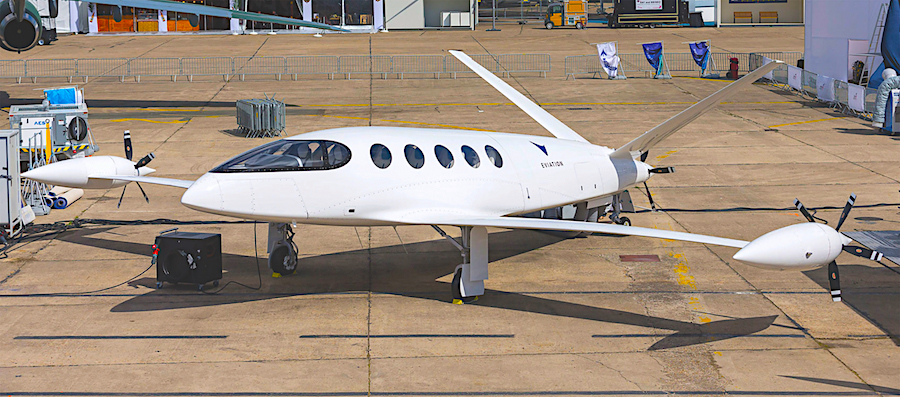PROVINCETOWN — Cape Air founder and CEO Dan Wolf says he is excited about the future of his fleet. At the same time that his company is replacing its aged Cessna 402s with a sleek new Italian model, the Tecnam P2012 Traveller, he is also looking ahead to an entirely new generation of all-electric planes that Cape Air is helping to develop with an Israeli company, Eviation Aircraft.
Reducing its carbon footprint is a high priority for Cape Air, Wolf says, and Alice, the electric prototype, promises to deliver on that count, though major technological and regulatory hurdles remain.
Cape Air is one of the largest regional airlines in the U.S., with nearly 100 planes making 400 flights a day between 35 ports and carrying half a million passengers per year. Destinations include the Cape & Islands, other Northeast airports, the Midwest, Montana, and the Caribbean.
A significant number of those flights are subsidized by the federal government’s Essential Air Service (EAS) program, which supports routes serving smaller, more isolated places. If you’ve ever wondered, while studying Cape Air’s route map, how the airline can afford to fly to places like Kirksville, Mo. and Lebanon, Mont., that’s the reason.
Cape Air’s share of EAS funds will total about $43 million in 2019, which is close to half of the airline’s total estimated revenue. This subsidy is a big reason why Wolf expects to be able to upgrade and expand his fleet and service in the coming years.

An Italian Traveller
In September the company took delivery of its first P2012 Traveller, at a reported cost of $2.7 million. Cape Air has placed orders for 20 Travellers, with options for up to 92 more. They will be integrated into the fleet over the next decade.
Wolf says it was tough finding the right partner to create a plane to replace the workhorse Cessnas. He had to go outside the U.S. to do it.
“The only company that would give us what we were asking for was Tecnam,” he says. “Nobody in the U.S. would build us an airplane.”
While the Cessnas have about a 12-percent higher maximum speed and a 25-percent greater range, the Travellers have better fuel economy. Lower baggage compartments make loading on the ramp easier. All the passenger seats and the entire cabin floor can be removed in minutes, so inspections and routine maintenance go faster. Cape Air’s numerous short hops made the lower range of the Traveller not a deal-breaker.
But Wolf is looking beyond the Italian plane to the electric model he calls “a game-changer.” He’s hoping to put as many as 10 of the planes into service by 2024.
Eviation’s Alice is said to be the first commuter-class aircraft that relies solely on electric power. It comes at a cost of nearly $5 million each.
“They’ve been a very good design and development partner, really trying to understand the airplane that we need and trying to build around that,” says Wolf. Early estimates predict the direct operating costs of the electric fleet will be about 40 percent of what Cape Air is currently spending.
As a development partner with Eviation, Cape Air is working on airworthiness certification from the FAA to start operating Alice. That campaign is set to begin in 2020 with a flight-test program in Arizona expected to last 24 to 30 months. Even if all goes well, there are major obstacles to certification, including getting the FAA to approve what would be the very first all-electric multi-engine airplane for commercial service in the U.S.
The plan is for the electric planes to initially serve the Cape and Islands routes, including Provincetown, Boston, Hyannis, Martha’s Vineyard, and Nantucket. The goal is to have charging stations at every airport.
Alice’s lithium ion batteries will provide instant power to the engines so the plane can take off on shorter runways. They also will allow two hours of flying time for every hour on the charger. But one big challenge is the heavy batteries. At 8,200 pounds, they’re well over half the aircraft’s maximum takeoff weight of 14,000 pounds.
The planes have an unconventional look, with two rear-facing propellers on the wings and one on the tail cone. Eviation says the design is tied to the craft’s electric motors. They are reported to be extremely durable, due to their simplicity, with a life span of up to 20,000 hours. The Cessna 402 engines have just a 2,000-hour life span.

Faster and Farther
Electric Alice planes will fly nearly 50 percent faster and farther than their gas-powered counterparts, with top speeds of close to 300 mph and a range of 650 miles. While this may cut flight times on short hauls, Wolf is looking at using the efficiency to expand.
“For example, it makes New York a lot more viable option,” he says.
Cape Air’s electric future may well depend on continuation of the federal EAS subsidies. Funding for 2020 is still awaiting passage of the federal budget. Last March the Trump administration proposed a $30 million cut to the program, arguing that many of the flights take off unfilled.
Wolf says that paying for the new aircraft will be accomplished with a combination of debt and equity. He’s confident, he says, that there will be so much interest in Alice that raising funds won’t be an issue.
After 30 years in business, Wolf says he welcomes the chance to reduce his airline’s environmental footprint, and he hopes the government will see things the same way.
“There’s going to be an opportunity for the government to actually support the transition to carbon-free transportation,” he says. “We’re excited about that.”



